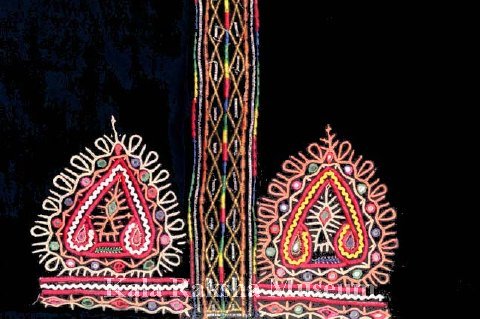|
Description
|
| MATERIALS: Synthetic cloth, cotton threads, rickrack, mirrors and mettalic threads. CONSTRUCTION: Machine stitched, hand and machine embroidered: square chain, cretan, buttonhole, detached chain, fishbone, couched, interlaced stitches. MOTIFS: shravan, geto, limbudi tak and popti. COLOURS : Multicoloured on black. STYLE REMARKS: Use of machine embroidery and rickrack saves time, enabling women to work for wages. Shravan is an contemporary motif adapted from the traditional paniari. Machine embroidery is generally done using in traditional Rabari motifs. CULTURAL SIGNIFICANCE: Worn by young Kachhi Rabari women. Among Kachhis, cotton cloth replaced the traditional wool skirt except for ceremonial occasions by the early 1970's. This was replaced by synthetic cloth by the late 1970s-early 1980s, as Rabaris began to go to the Middle East and purchase cloth there. Today, even for ceremony these fabrics are accepted. Dhebarias and vagadias, in contrast, maintain the wool tradition. The embroidered motifs on either side of the seam are worn by younger women. CULTURAL REMARKS: Cloth was brought from Mascut from 1970s on when Rabari men started to go to Middle East for work. Synthetic cloth from the Gulf became a status symbol. Paheranu, Skirt. |
Paheranu
-Rabari Arts
-Copyright Statement

COPYRIGHT INFORMATION ~ When using this image, the credit information should be in the following format: Image courtesy of the Kala Raksha Museum.

COPYRIGHT INFORMATION ~ When using this image, the credit information should be in the following format: Image courtesy of the Kala Raksha Museum.